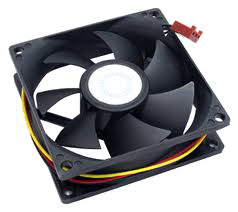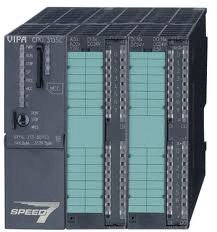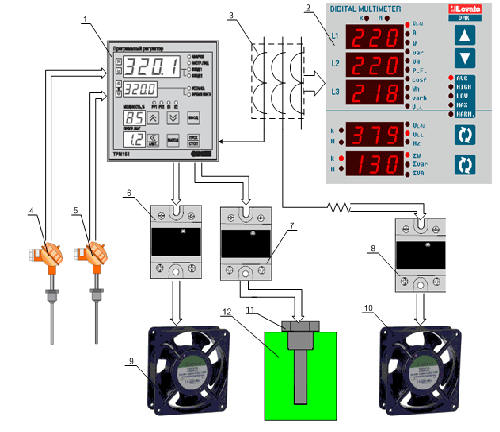 Starodub Mihail
Starodub Mihail
"Electrotechnical faculty"
Chair "Electromechanic systems of automation and electric drive"
Speciality "Electromechanic systems of automation and electric drive"
Development of multi–level thermal management processes
Leader of work: Svetlichnyi Olexiy
Содержание
1 INTRODUCTION
2 LITERATURE REVIEW
3 DEVELOPMENT OF SCHEME
LIBRARY
ABSTRACT
INTRODUCTION
The main areas of engineering professionals in the field of electric drive and automation is designing,
construction and operation control systems, power converter devices, measuring systems and more. Implementation of management
systems of modern electric drives based on the useing of microprocessors and computers, which present a professional qualification to
engineer a number of additional requirements to master which are the new information technologies engineering work. Successful graduates
of technical universities competition in the labor market is possible only at sufficiently high level of theoretical and practical engineering training.
As the requirements for employers to quality training continuously strengthened, it substantially increases the role of laboratory practical
work in the educational process.
Working with microcontroller systems control actual hardware is available in limited volume of laboratory works and
the degree of design, due to the high cost of equipment and the small number of educational booths. Nowadays, the use microkontrol modules
in practical laboratory and course design has become more affordable because there inexpensive sets of specialized companies
that allow students to use them as separate devices, and systems in stock.
The development of modern computer technology allows to implement complex control algorithms in real-time.
Digital control systems have several advantages compared with analog, resulting in simplicity and flexibility of control algorithms. Therefore,
knowledge of experts in this direction is extremely important, and to form their necessary practical skills are essential in the learning process
using modern specialized laboratory equipment.
LITERATURE REVIEW
Modern education in Ukraine aimed at realization of high capacity computer and telecommunication technologies that allows
new forms of educational process, greatly improve training and, above all, self&ndashefficacy of students, the share of the total volume of training is
constantly increasing.
 Picture 1–culler
Picture 1–culler
An important part of the educational process of all specialties are electromechanical laboratory practice.
Development of laboratory facilities must go through the creation of new modern laboratory facilities and physical models. Latest computer
technologies allow ample opportunity for various experiments on mathematical models and real.
One effective means of studying processes of functioning of electromechanical systems and automation systems,
intensification and improvement of research are engineering work is research based on computer modeling that ensures efficient calculation
of steady and transient modes in regular and abnormal operating modes. Methodological and methodical basis for mathematical modeling of
devices based on power electronics and microprocessor technology is a systematic approach, simulation and analytical modeling. Modeling
difficulties caused by their heterogeneous physical nature, topology and mathematical complexity of the models, the necessity of multilevel
modeling. The disadvantage of this approach is the study of virtual models that do not give a clear understanding of the structure of real system
and not allow to get practical experience working with hardware.
Development of the complex was performed with the following requirements:
- data from two channels simultaneously, synchronization and logging to file input and output signals;
- provide the required output voltage harmonic structure and the possibility of change;
- opportunity to observe the harmonic structure of power in real time;
- simple circuit implementation and the ability to use speed control algorithms on microprocessor element basis.
 Picture 2–Temperature trends of the airspace in the stabilization mode at power nagrivatelya 220W
Picture 2–Temperature trends of the airspace in the stabilization mode at power nagrivatelya 220W
The complex contains in itself the following elements:
- personal computer – implementing automation functions for diagnostics, software interface, data collection, processing results and changing
weights three harmonic voltage so as to maintain a harmonious composition of electrical power to the load;
- pulse–width converter implemented on a microcontroller, power transistors and power transistors and drivers designed for supply voltage;
- unregulated dc voltage integral transformer &ndash Power sells power driver transistors.
As the basic equipment used to implement complex demonstration booth CC&ndashLink Demo&ndashcase company Mitsubishi.
The stand is designed for remote control of discrete objects and continuous and has several advantages:
- multyprotsesornyy work;
- The large number of communication interfaces;
- open architecture construction.
 Picture 3–Vipa controller
Based on the experience of these and other works necessary to develop software and hardware for the
study of thermal processes as the most convenient for implementation. The stand must meet the following requirements:
Picture 3–Vipa controller
Based on the experience of these and other works necessary to develop software and hardware for the
study of thermal processes as the most convenient for implementation. The stand must meet the following requirements:
- Physical model.
- Availability of equipment and PLC.
- Communication equipment and PLC with PC.
- Manage PC.
- Availability of software.
- Establishment of a heating and cooling
DEVELOPMENT OF SCHEME
In developing the functional scheme, it is necessary to determine the basic elements that make up its membership.
Please specify the number of such elements, their purpose and functional capacity. These include:
- Temperature sensor
- KVP or PLC
- Trasformator
- Regulators
- Cullers
Using these requirements and those that unique to each system component separately, was selected elements
of automation, which in the future will be installed on the stand.
 Picture 4–schema of laboratory stend
1–PID–regulator, 2–parameters of a network analyzer, 3–Three-phase current transformer 20 / 5,
4–temperature sensor airspace, 5– temperature sensor control object, 6–Power control fan 2, forcing the air, 7–Power control heater,
8–Power control fan 1, which sucks air, 9–Fan 2, forcing the air 10–Fan 1, which sucks air,11;&ndash heater 12–the object of regulation.
Picture 4–schema of laboratory stend
1–PID–regulator, 2–parameters of a network analyzer, 3–Three-phase current transformer 20 / 5,
4–temperature sensor airspace, 5– temperature sensor control object, 6–Power control fan 2, forcing the air, 7–Power control heater,
8–Power control fan 1, which sucks air, 9–Fan 2, forcing the air 10–Fan 1, which sucks air,11;&ndash heater 12–the object of regulation.
LIBRARY
- Electromechanical system modeling and optimization. Scientific Papers of VII All&ndashUkrainian scientific&ndashtechnical conference of young
scientists and specialists in the city of Kremenchug , 2009 – Kremenchug, 2009.–414 p. .
- Ventylyatorы and air-otopytelnыe aggregates.: Catalog-Handbook. CH.1.&ndashM: Mashmyr, 1992.–220 p
- Коган А.Д. Изготовление и монтаж вентиляционных систем: Справочник / Коган А.Д., Шепотько А.П..–К: Будівельник,1990.–192 c.
- Иванов О.П. Аэродинамика и вентиляторы. Учебник. / Иванов О.П., Мамченко В.О.–Л: Машиностроение,1986.–80 c.
- ДЖ. ФРАЙДЕН Современные датчики. Справочник. Перевод с английского Ю. А. Заболотной под редакцией Е. Л. Свинцова ТЕХНОСФЕРА Москва Техносфера–005
- Котюк А.Ф. Датчики в современных измерениях. Москва. Радио и связь–2006
Up




 Starodub Mihail
Starodub Mihail